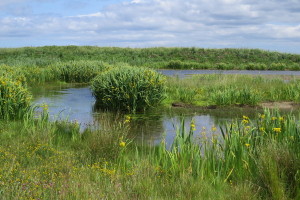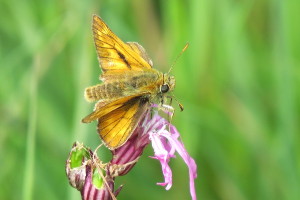Morning seawatch 09:35-11:30 produced:
Long-tailed skua 1 juvenile north, Great Skua 1 north, Pintail 2 north, Manx Shearwater 40 north, Wigeon 12, Common Scoter 4, Pale-bellied Brent Geese 12.
Morning seawatch 09:35-11:30 produced:
Long-tailed skua 1 juvenile north, Great Skua 1 north, Pintail 2 north, Manx Shearwater 40 north, Wigeon 12, Common Scoter 4, Pale-bellied Brent Geese 12.
On Thursday evenings in the summer, I always try to go birdwatching after work. As the autumn is fast approaching, bringing with it the dark nights, I decided to go further than the usual Holywell or Swallow I usually visit then.
A drive up to East Chevington proved well worth it. The juv Spotted Crake was showing well at times. Close by were 2 Curlew Sandpipers and a handsome Pectoral Sandpiper. Directly in front of the hide there were 25+ Ruff, 9 Black-tailed Godwits, 1 Greenshank, 5 Ringed Plover, 100+ Lapwing and 20+ Dunlin. Amongst the waders there was a visiting
White-rumped Sandpiper, which was not only showing well, but I was lucky to catch a glimpse of the famous white rump as it took to flight on one occasion.
I wonder what else could turn up at Chevington this autumn? The reserve is certainly full of life at the moment, reminding me of the days when Swallow and Backworth were full of autumn waders in the 80s/90s.
Finally a flock of Greylags and Canada flew in, with three most likely escaped Bar-headed Geese. Other wildfowl present, included a female Pintail, 25-28 Wigeon and 100+ Teal.
Paul Buskin
A blustery morning at Cresswell and 2 Marsh Harriers were causing panic among the waders and duck present,with another harrier at Druridge, possibly one of these? Several Greenshank,Common Sandpiper and 2 Yellow Wagtails were among the Cresswell birds. A Whimbrel called overhead at Druridge.
East Chevington and migrating flocks of Ruff and Black tailed Godwits were evident throughout the afternoon. 59 Godwits and 36 Ruff flew in as I arrived and began drinking in the shallows before heading off south. Then in came another 32 Ruff and 17 Godwits,high from the north east,which immediately began to drink and preen, followed by 20 more Ruff and 7 Godwits. The two species always keeping close together. The vast majority being juvenile birds. A single Curlew Sandpiper also noted with several Dunlin.
The long-staying juv. Spotted Crake showed very well all afternoon and around 250 Grey Lags also present.
Down to Woodhorn,where large numbers of gulls fed in fields where tractors had been working. Among them at the south flash I saw 11 Med. Gulls and at the Church Pool a further 10 ( these from A. Tilmouth).
3 Little Egrets today at Alnmouth road bridge and 6 Curlew Sands at Amble Braid.
A.S.J.
This morning at St Marys and for once ,I was completely alone on a lovely warm ,sunny day. No crowds of dog-walkers to disturb the birds.
A juv Wheatear fed along the promenade and the first south- bound Meadow Pipits of the year flew over calling ,as did several Sand Martins. A group of 30 or so Swallows ,including 20 youngsters circled above. The bushes seemed quiet ,a single Willow Warbler briefly sang, it could be eight months before I hear another. Two Speckled Wood butterflies noted and four Small Coppers.
A flock of Black headed Gulls suddenly came up ,calling from the rocks of the north bay and the reason for their stress was among them. An Osprey! They mobbed it as it flew quite low over the main car park and headed south ,out over the rocks. Very Nice!
On the rocks were around 100 golden Plover,50 Lapwings,30 Ringed Plover and 70-80 Sanderling.
A.S.J.
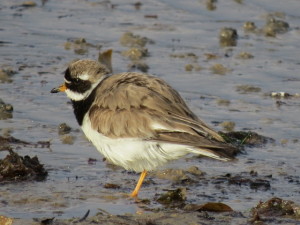

A bright sunny morning produced a small number of migrants on the Ash Lagoon bank scrub including a 1st-winter Red-backed Shrike, 2 Whinchats and a single Lesser Whitethroat. Four Grey Partridges on the golf course and a 30+ charm of Goldfinches.
Sparrowhawks, having bred successfully nearby this year, were much in evidence around the golf course and Ash Lagoons with up to 3 juveniles in the area.
AT
Over the bank holiday weekend we decided to stay overnight on Holy Island for the second time this year. At the Lough there were Willow, Garden and Reed Warblers. These were joined on the Monday by a Stonechat and a Spotted Flycatcher, which showed well, sitting on the fence post to the right of the hide. There was also plenty of Swallows, many landing in the trees either side of the hide. On the Lough itself, there was a pair of Mutes Swans, half a dozen Teal and a single Little Grebe.
At Coves Haven we stopped to do a couple of hours seawatching. There was lots of southward passage, which included over 250 Gannets, 1 Artic Skua, 1 Great Skua, 6 Teal, 1 Bar-tailed Godwit, 55+ Sandwich Terns, 12 Artic Terns and 4 Auks.
Also on the Island there was a Wheatear near the castle both days and a second on St Cutherberts Isle on the Monday. There were also lots of Goosander and R B B Merganser.
Paul & Adriana Buskin
This morning at St Marys, the first hint of Autumn’s passage of migrants ,with Whinchat,2 Pied Flycatchers, a Spotted Flycatcher ,Garden Warbler and several Willow Warblers in the bushes. 2 Yellow Wagtails on the beach as were an adult and a juv. Curlew Sandpiper.
A message alerted me to what would be another county life-tick at Hadston , a Booted Warbler. A pale Hippolais warbler from the Russian Steppes. It was thought to have been present yesterday,with I. D. clinched this afternoon. It typically gave fleeting views over an hour or two in increasing rain, sometimes feeding on the sandy ground or in the scattered Hawthorns. Occasionally,pausing allowing decent views.Amazingly, it was in the very same bushes as it’s close congener from a couple of years ago , Sykes’s Warbler! My 5th county year -lifer.
Heading down to the hides at Druridge and Cresswell to escape the heavy rain, 5 Common Sands and 2 Dunlin were in front of the Druridge hide ,before a young Peregrine slowly glided by carrying prey. 2 Whimbrel flew over,calling.
Cresswell was busy ,with water levels condusive to feeding waders. A Little Stint,my year’s first.2 juv Spotted Redshanks,2 Whimbrel, a Curlew Sandpiper and3 Greenshanks and an Avocet all fed in front of the hide. Panic then ensued as a juv Marsh Harrier floated in over the reeds,before heading off north.
I did hear today of a Honey Buzzard being seen yesterday over Big Waters. Short eared Owl at Prestwick Carr too.
A.S.J.
At Castle Island this morning,17 Herons was a good count. A pair of Stonechats with 2 fledged young at Druridge.
A look at the estuary at Amble at low tide revealed a good number of feeding waders. Among the many Dunlin ,Redshanks and Curlews was a Greenshank, a moulting adult Curlew Sandpiper showing remnants of it’s breeding plumage with red underparts and a Whimbrel circling ,calling. Two female Stonechats were in the dunes at Warkworth.
At Widdrington, a Peregrine flew towards the coast and a Sparrowhawk,Buzzard and Kestrel also seen .
Foxton was quiet,so I headed inland,enjoying superb views of plenty of purple heather on the Alnwick moors and Simonsides. In Upper-Coquetdale several family parties of Whinchats were seen in the bracken . Looks like they have had an excellent breeding season. As do Wheatears ,with fledged birds quite obvious.At Hepple, a Kingfisher was disturbed near the bridge over the Coquet,calling as it flew. 3 more young Wheatears chased insects on the rocks near the river and a large flock of Swallows and House Martins gathered in a dead tree.
A.S.J.
Castle Island on Sunday 18th proved a good stop ,as 27 Black tailed Godwits fed in the muddy shallows of the island. Nearby,among the flocks of Lapwings and Black headed Gulls,were 3 Green Sandpipers, a Greenshank and a Common Sandpiper. A female Gooseander fished the river,as did several Common Terns.
Moving on to Cresswell where I had just missed a Merlin go through,a Barn Owl showing well,and a Spotted Redshank on the mud . 3 Knot, several Greenshank and a Common Sandpiper had returned to feed. Another good number of Black tails here, this time 23 in total, some coming in from the north east.
Heading up to Druridge Pools, a Common Sandpiper and a Yellow Wagtail showed in front of the hide,and a family of 4 Otters had been seen earlier.Two Kestrels seen also. A Sparrowhawk caused panic among the Swallows and Sand Martins feeding over the main pool, 40+ of the latter counted. Large young in the Swallows nest in the hide.
Butterflies included around 25 Walls, 15 Large Whites, a Small Copper and one of each of Dark Green Fritilliary and Comma. Several Peacocks and Tortoiseshells.
At St Marys, today 81 Sanderling now and 36 Ringed Plover on the beach with a single Bar tailed Godwit. A large flock of Oystercatchers gathered at their high tide roost on the island. 80-90 House Sparrows was noteworthy too. No sign today of the increasing Golden Plover flock. No doubt in the nearby fields somewhere.
At Seaton Sluice , 90-100 Swallows, 4 Sand Martins and several House Martins were gathered on wires and feeding over grass banks, many of the Swallows being youngsters.
Here on the 19th, 7 Whimbrel flew south.
A.S.J.
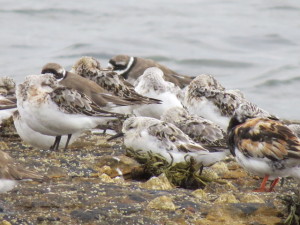

On the 15th at St.Mary’s Island: Ruff flew south. 55 Sanderling, 37 Ringed Plover, Bar tailed Godwit and 23 Dunlin on south beach.
Arctic Tern and 4 Sandwich Terns on rocks. Yellow Wagtail,juvenile at the pond.
At the Bee Hive Flash: 7 Greenshank, 1 Green Sandpiper, 33 Curlew, 4 Yellowhammers.
On the 14th at Holywell Pond: 4 Green Sands, 4 Greenshank,1 Common Sandpiper.
On the 12th at Bee Hive Flash: Spotted Redshank, part of a small influx into the North East with birds in Northumberland, Durham and Teeside. Green Sandpiper.
On the 12th at St Marys: Balearic Shearwater ,several others seen next day. Sooty Shearwater,3 ( 2 from J. Bucknall ). Manx Shearwater 5.
On the 14th at Cullercoats: Pomarine Skua flew north. 41 Oystercatchers at roost.
A.S.J.
Well known scoundrels Tim Cleeves and Maurice Hepple came up trumps again yesterday with a brief visit to Cresswell Pond of an adult Bonaparte’s Gull that dropped in front of the hide to bathe and preen for around 10 minutes before continuing south.
Maurice kindly sent one or two images over for the website for which we are grateful.
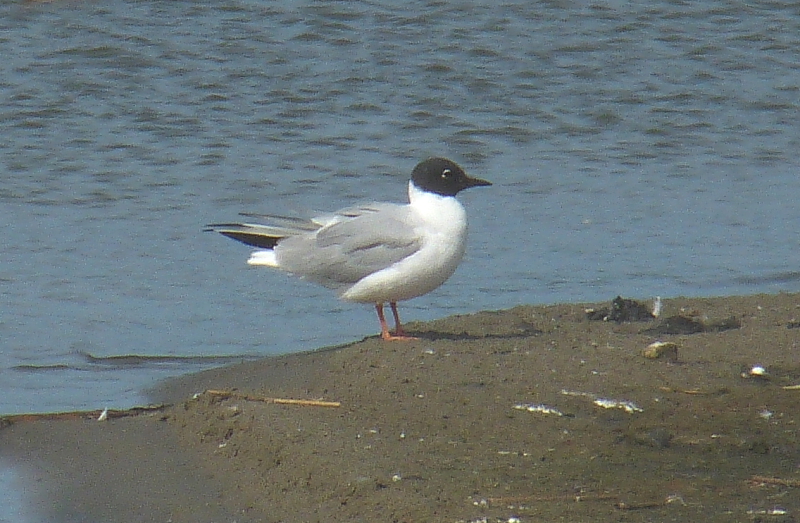
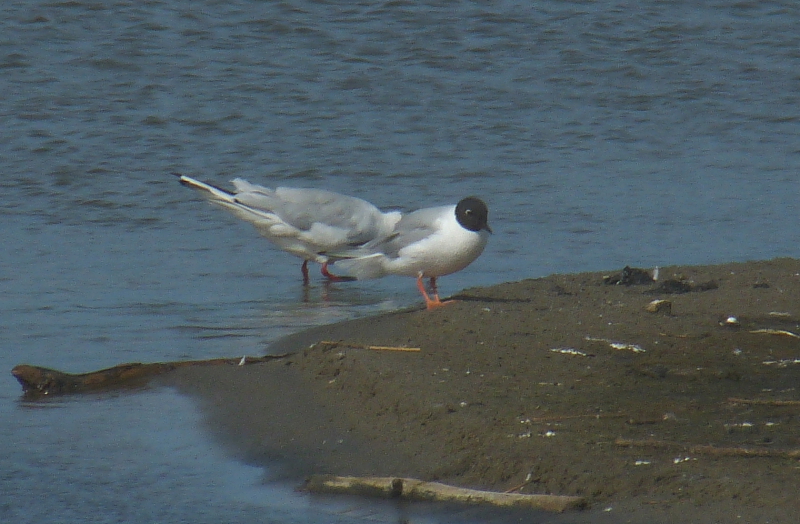
A run up to Druridge Bay this morning, starting at Cresswell, where 6 Avocets remained ( 1 adult), 4 Greenshank and a Common Sandpiper on the sparse mud and a drake Scaup on the pond. Up to Druridge Pools and a Cuckoo flew south. Yellow Wagtail and Common Sandpiper in front of the main hide and around 150-200 Sand Martins feeding over the pools. Butterflies included 2 Dark green Fritilliaries, a Comma,20+ Large Whites and 5 Tortoiseshells and 3 Peacocks. ( 9-10 Painted Ladies in my garden now).
Chevington held 50-60 Common, Arctic and Sandwich Terns . A single Ruff and a pair of G. C. Grebes with one youngster.Yellow wagtail flew over. I had only been gone ten minutes, when the pager flashed with news of a good find -a juvenile White winged black Tern at the North Pool.Neil Osbourne had scored with this one. I returned ,along with a few other guys who had been there earlier ,be-moaning their bad luck. Such is birding. The Tern dip-fed over the pool,showing very well to the growing crowd,livening up what had been a quiet day.
Up to Hauxley,where 3 Whimbrel,a Green Sandpiper, Common Sandpiper and 4 Little Egrets were the highlights. A family group of 6 Little Grebes were close to one of the hides and 172 Curlew, 59 Oystercatchers and 48 Gadwall counted on the reserve.
A.S.Jack
St Marys Island: Knot,23 Sanderling,19 Turnstones, 700 Golden Plover . 2 Med Gulls, ( 1st summer and adult). Reed Warbler, 3 Whitethroat juvs.
Bee Hive Flash: c 200 Swifts feeding.
Backworth: c 300 Swifts feeding, Wood Sandpiper,Green Sandpiper, Kestrel Pair
Holywell Pond: Green Sandpiper,Greenshank, 4 Bar-headed Geese. 8 Common Terns .
Whitley Bay: 100 and 60 Swifts on territory at 2 sites. (evening).
A.S.Jack
A bright,breezy day and at St. Marys a scarce visitor these days in the form of a Stonechat, feeding from a fence line . Having bred here in the past this species took a real hit over the last few hard winters and is a rare visitor now.
12 Whimbrel noted , including one with 43 curlews in the fields. 11 flew south. A Red throated Diver still sporting a nice red throat on the sea. Gannets and Terns in good numbers offshore and a flock of 20 Common Soter. A few Turnstones ,Sanderling and Dunlin on the beach. Reed Warbler singing at the pond.
At Holywell, Greenshank ,2 Green Sands and a Dunlin feeding on the mud and a pair of fledged Common Terns in front of the public hide. A juv Marsh Harrier seen again, flying west.
AS Jack.
Druridge Bay today ,starting at Cresswell where 6 young Avocets fed while their parents dozed in the sun – 11 birds in total counted. 5 Greenshanks,3 Black tailed Godwits and a few Dunlin present too. The water levels are very high unfortunately after high tides and some heavy overnight rain lately. 40 Swifts fed above.
At Druridge Pools a female Stonechat noted and A pair of Sedge Warblers feeding young in the nest. A nice Comma butterfly basked on a nettle among the many Large Whites present. At the hide, Green , Wood and Common Sandpipers seen and a single 1st summer Little Gull. Also 3 juv. Yellow Wagtails and a family of Tufted Duck, 2 Common Terns and a juv Kestrel noted. Swallows in the hide were incubating a second brood, quite oblivious to my presence. A Whimbrel and Black tailed Godwit circled above calling.
Up to East Chevington where the Spotted Crake showed well,bathing and preening out in the open for 5 or 6 minutes. Waders present included 2 Ruff, Bar tailed Godwit,Whimbrel and Dunlin.
A S Jack

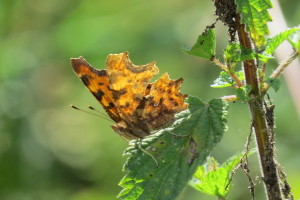
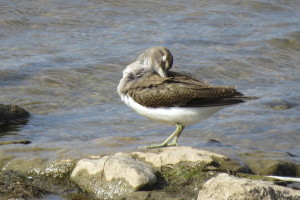

A lovely ,warm sunny morning at St. Marys Island and the Golden Plover numbers are starting to grow with around 250 flushed from their island roost,as the tide receded and the public began to cross the causeway. Calling,they alighted on rocks close to me,many still in summer plumage. They should be here right over the winter,weather permitting. With them were a few Dunlin and Turnstones, recent arrivals from Northern Europe. Sandwich Terns rested on the rocks,with a few Kittiwakes.
The water level at the pond has risen after recent rain and no waders present.
A few birds still singing -Reed Bunting, Sedge Warbler , Whitethroat, Meadow Pipit, Reed Warbler and 2 Grasshopper Warblers.
A.S.Jack
Arriving at Cresswell Pond yesterday morning, I had only time for the briefest of looks before a message came through of an adult Spotted Sandpiper at Foxton. 20 minutes later I was watching what was a county tick ,yet another in this good year for new county birds for me,this being my 4th. I had seen the last Spotted Sand. some years ago at Derwent Reservoir,but only from the Durham side .
A cracking find ,the bird fed below the road ,on the river’s muddy edges. Most of the county’s regular twitchers began arriving as the morning went on. Also present on the river ,were 4-5 Common Sands,a Greenshank, 3 R. B. Mergansers and a Kingfisher.
I left,heading up the coast to Newton,where a walk to the Long Nanny revealed a host of butterflies in the wild flower patches that have survived the dry summer,the grass being burnt brown. I noted at least 50 each of Meadow Brown, Common Blue and Small Heath. Also Several Tortoiseshells, and Small Skippers and 9 or 10 Dark Green fritilliaries.
At the Nanny Burn, around 500 Arctic Terns were on the beach,many feeding fledged young-no L ittle Terns now. Sadly, the remains of 6 young terns were seen , victims of predators. Perhaps one of the culprits hovered above in the shape of a Kestrel. Resting on the beach were 35 Sanderling, in various states of plumage moult ,a few Dunlin with them.
Back down to East Chevington ,where water levels look excellent for passage waders this summer/autumn. Feeding on the mud were 6 Knot,35 Dunlin, a Wood Sandpiper,Curlew Sandpiper and Green Sandpiper also a Little Egret was catching plenty of small fish. Good numbers of terns and Lapwings here too.
A S Jack
A long day delivering record cards for the NTBC bulletin authors plus memory sticks with rarity descriptions for the County Records Committee. Luckily these people live near birdy places ! Hence a summary here of sites visited & highlights.
Alnmouth – No Roseate Terns on the beach as high tide but always worth checking the tern gathering here on the S side of the burn. Warkworth Gut – Again quiet due to high tide but should have some wader interest from here on. Foxton Bends – Looking down on the fields from the high viewpoint near golf club. two Common Sandpipers
Hauxley – Surprise Red Kite drifting slowly over fields viewed from Ponteland Hide. Only visible for ten seconds. Apparently one at Red Row ten days ago so maybe keeping to Druridge Bay. My first Red Kite sighting along the coast. One Knot from Ponteland hide but again scope for waders here. East Chevington – One adult Little Gull in full summer plumage amongst terns. Water level nicely dropping and waders can now wade !
Two Common Sandpipers Druridge Pools – Reserve apparently left to grow into a rushy field.The female Mandarin showing well from Oddie hide. Has been present for some weeks. Also one 1st summer Little Gull. Cresswell Pond – One adult Little Gull. Little scope for waders as sandbank blocked again. One Common Sandpiper & 40 Dunlin Snab Pt, Cresswell – One summer Mediterranean Gull Lynemouth Flash – Dry
Newbiggin – Ten adult Mediterranean Gulls in S bay , most with full hoods. Worth checking the Beacon Pt tern roost for Roseates. Bothal Pond – Little of note Castle Island – Looks very good for waders. 7 Black-tailed Godwits & 1 Greenshank here. No sign of recent Ruddy Shelducks Arcot Pond – Little of note St Mary’s – Ditto TRD
On a visit to the Roman Fort at Housesteads, we stopped off at Grindon Lough for lunch. We didn’t’ come across any Romans, however we were lucky to experience excellent views of a Raven, which initially arrived at a some distance, eventually landing close to the water. It only stayed for 15 mins and then continued on its journey. There were lots of Rooks and Carrion Crows also in the area.

We also observed 2 Buzzards, and a family of Red legged Partridge which were busy marching across road as we were parking up.
Paul & Adriana Buskin
A cycle ride today again in hot conditions,though quite a stiff north easterly blowing offered some respite. My route was Stannington , Tranwell to Whalton, Shilvington to Ogle, Twizel and Saltwick Hill. This offered peaceful riding along quiet country lanes and a wealth of bird and insect life.
Again,many Yellowhammers singing from bush-tops,with 29 males counted. Skylarks too into double figures,as were Whitethroats. Bullfinch ,Long tailed Tit ,Blue and Great Tit. Linnet and Willow Warbler , all in family parties as birds seemed to be having a very good breeding season this year in the settled weather. 2 Marsh Tits seen at different sites and at Tranwell, Nuthatch and Gt spotted Woodpecker heard. At a site on the upper reaches of the River Blyth , splendid Banded Demoiselle males dragonflies chased each other. Dozens of Trout and several frogs could be see in the clear river. Butterflies included many Meadow Browns , Ringlets and Common Blues, as well as several Skippers and Walls.
At Shilvington , a colony of House Martins was very active ,with young both fledged and still in the nests being fed. Good numbers of Swifts and Swallows fed over fields . Oystercatchers, Curlews and Lapwings were feeding in newly harvested fields ,with hundreds of corvids and Black headed and Common Gulls.
A.S. Jack.
The south bay has an early morning gull and tern roost that this morning attracted 2 adult Roseate Terns and 3 Little Gulls. This had dispersed by 09:30 with many birds moving into the quieter north bay.
Mid-morning two adult Roseate Terns were in the small roost at Beacon Point along with two 1st-summer Little Gulls. Golden Plover numbers continue to increase with 45 present this morning along with 4 Sanderlings. The roost was spooked by an Arctic Skua and one of the local fishermen over the space of an hour.
Whilst watching the roost I noticed some Manx Shearwaters close in flying south, I was surprised as the string of birds kept coming into view and counted c.50 in this single group.
Highlights
Little Egret 1 at Castle Island on 9th, passage of Common Sandpipers with a peak of eight so far.
Marsh Harrier – juvenile/female at Woodhorn Flashes on 10th
Little Gull, 2nd-summer in Beacon Point roost (11th), Sanderling 14 and Golden Plover 35 between Church & Beacon Points.
A run up to the Bay in the hope of another view of the mobile Bridle Tern ,on it’s return from a visit to Saltholme , saw me join around 120 very disgruntled folk, either staring into space at Chevington or searching among the hundreds of feeding terns off Cresswell village . Out of these guys, only one other was a local. Much grumbling was heard about giving up twitching!
Back to those common Terns, and yes, many were of that species , together with Arctic and Sandwich either loafing on the rocks ,or bringing in fish to the many young birds – around 400-500 birds in total. An Arctic and a Pomarine Skua caused a bit of concern ,before moving on .
Up at East Chevington, another mixed group of Terns- about 100 on the N. pool.
A Barn Owl hunted at Cresswell,hovering often in the dunes and taking prey to it’s young. A single Avocet, a Little Gull and 2 Black tailed Godwits also here, as were several Reed and Sedge Warblers,and a Grasshopper Warbler. ( On my last visit a few days earlier 5 Arctic Skuas were at the pond , before flying south west ,then turning over the village to reach the sea).
Down at St Marys, the first returning Golden Plover seen on the rocks -29 birds with 6 Dunlin. A 2nd year Med. Gull also on the shore and an adult seen at nearby South Beach, Blyth.
A.S. Jack ( inadvertently omitted my name from last St Marys post.)
A short visit late morning/early afternoon produced the first post-breeding ‘flock’ of Common Sandpipers with eight around the east end of the island. A little further east a pair of Ruddy Shelducks presumably the two that flew south over Cresswell yesterday and given mid-summer timing probably overshooting moult-migrants from Emmeer in Utrecht, Netherlands. Worth an insurance tick in case BOU ever upgrade them to Cat C5…
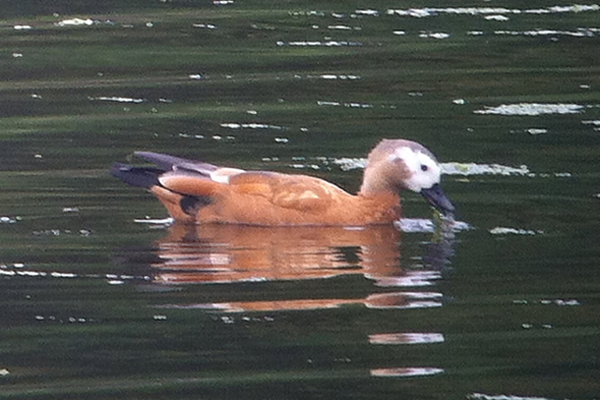
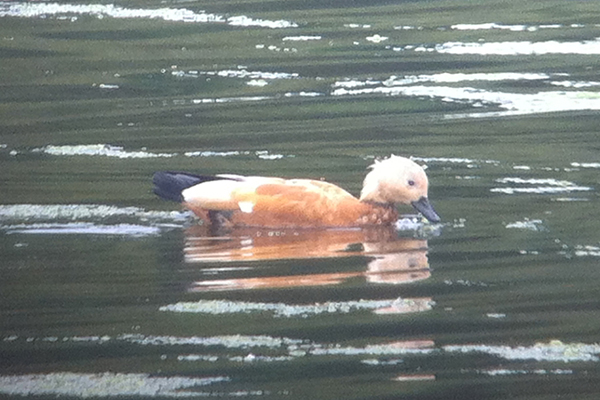
Breeding birds at the Wetland and surrounding area are now mostly feeding fledged young,with species seen including Reed Warbler,Sedge Warbler,Reed Bunting.Meadow Pipit and Whitethroat,all of these still singing too. The warm,sunny conditions meant lots of insects on the wing and taking advantage of the glut were House and Sand Martins , 40 and 15 respectively. Swallows with attendant young, 5 lined up on bushes waiting to be fed, and many Swifts over the fields. 5 Skylarks sang and several more were seen in the long grass.
A profusion of wild flowers attracted many butterflies. Meadow Brown 8, Common Blue 15-20, Small Skipper 20, Ringlet 4, and Small Copper 1. The pool edges held 10 Lapwings,15 Redshank and a Dunlin. The only duck was a single Teal. On the rocks at the shore , a party of Kittiwakes rested with a few Sandwich Terns and Cormorants.
